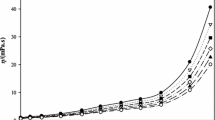Abstract
By use of a diamond anvil cell, we show that at high pressures aqueous solutions of tetra-n-butylammonium bromide form a closed liquid–liquid immiscibility loop with a critical concentration of about 2.0 mol-kg−1. We report data for a near-critical isopleth, which describes the pressure dependence of the upper and lower consolute points. At about 700 MPa and 373 K both consolute points coincide to form a hypercritical point, which characterizes the minimum pressure to achieve immiscibility. We show that this immiscibility can be rationalized in terms of Pitzer's ion-interaction theory. We determine the ion-interaction parameters of Pitzer's theory up to 423 K at normal pressure. Inclusion of volumetric data gives the correct trend toward a high-pressure immiscibility. We discuss the results in terms of the interplay between ionic and hydrophobic forces in this system.
Similar content being viewed by others
REFERENCES
K. S. Pitzer, in Activity Coefficients in Electrolyte Solutions, R. Pytkowicz, ed. (CRC Press, Boca Raton, 1979), p. 157.
K. S. Pitzer, J. Phys. Chem. 88, 2689 (1984).
K. S. Pitzer, Acc. Chem. Res. 23, 333 (1990).
R. Grzanna and G. M. Schneider, Z. Phys. Chem. 41, 193 (1996).
G. M. Schneider, in Water. A Comprehensive Treatise, Vol. 1, F. Franks, ed. (Plenum Press, New York, 1973), p. 381.
G. M. Schneider, in Chemical Thermodynamics. Specialist Periodical Report, M. L. McGlashan, ed. (The Chemical Society, London, 1978), p. 105.
G. M. Schneider, Ber. Bunsenges. Phys. Chem. 70, 497 (1966).
H. Weingärtner, Ber. Bunsenges. Phys. Chem. 93, 1058 (1989).
M. de Tobriand and M. Lucas, J. Inorg. Nucl. Chem. 141, 1214 (1979).
H. Weingärtner, T. Merkel, U. Maurer, J.-P. Conzen, H. Glasbrenner, and S. Käshammer, Ber. Bunsenges. Phys. Chem. 95, 1579 (1991).
H. Weingärtner and E. Steinle, J. Phys. Chem. 96, 2407 (1992).
H. Weingärtner, J. Chem. Thermodyn. 29, 1409 (1997).
K. S. Pitzer, J. Phys. Chem. 77, 268 (1973).
K. S. Pitzer and G. Mayorga, J. Phys. Chem. 77, 2300 (1973).
R. Grzanna, PhD thesis, Ruhr-Universität Bochum, Bochum, Germany, 1996.
D. J. Bradley and K. S. Pitzer, J. Phys. Chem. 83, 1599 (1979).
L. Silvester and K. S. Pitzer, J. Solution Chem. 7, 327 (1978).
P. S. Z. Rogers and K. S. Pitzer, J. Phys. Chem. Ref. Data 11, 15 (1982).
J. E. Mayrath and R. H. Wood, J. Chem. Thermodyn. 15, 625 (1983).
J. E. Mayrath, Ph.D. Dissertation, University of Delaware, Newark, Delaware, 1980.
S. Lindenbaum, J. Phys. Chem. 70, 814 (1966).
A. S. Levine and R. H. Wood, J. Phys. Chem. 77, 2390 (1973).
S. Lindenbaum and G. E. Boyd, J. Phys. Chem. 68, 911 (1966).
W.-Y. Wen and S. Saito, J. Phys. Chem. 68, 2639 (1966).
A. Lo Surdo and H. E. Wirth, J. Phys. Chem. 72, 751 (1972).
S. Schiavo, B. Scrosati, and A. Tommasini, Ric. Sci. 37, 211 (1967).
S. Schiavo, B. Scrosati, and A. Tommasini, Ric. Sci. 37, 219 (1967).
J. E. Desnoyers and P. R. Philip, Can. J. Chem. 50, 1094 (1972).
M. L. Japas and J. M. H. Levelt Sengers, J. Phys. Chem. 94, 5361 (1990).
M. Kleemeier, W. Schröer, and H. Weingärtner, J. Mol. Liquids 73/74, 501 (1997).
L. Haar, J. S. Gallagher, and G. S. Kell, NBS/NCR Steam Tables, Nat. Stand. Ref. Data, (U.S. Bureau of Standards U.S. Government Printing Office, Washington, D.C., 1984).
M. Uematsu and E. U. Franck, J. Phys. Chem. Ref. Data 9, 1291 (1980).
F. Franks, in Water. A Comprehensive Treatise, Vol. 2, Chap. 1, F. Franks, ed. (Plenum Press, New York, 1973), p. 1.
P. S. Ramanathan, C. V. Krishnan, and H. L. Friedman, J. Solution Chem. 1, 237 (1972).
H. Xu, H. L. Friedman, and F. O. Raineri, J. Solution Chem. 20, 739 (1991).
A. Ben-Naim, Hydrophobic Interaction (Plenum Press, New York, 1980), p. 185.
H. Weingärtner, M. Kleemeier, S. Wiegand, and W. Schröer, J. Stat. Phys. 78, 169 (1995).
M. E. Fisher, J. Stat. Phys. 75, 1 (1994).
G. Stell, J. Stat. Phys. 78, 197 (1995).
Rights and permissions
About this article
Cite this article
Weingärtner, H., Klante, D. & Schneider, G.M. High-Pressure Liquid-Liquid Immiscibility in Aqueous Solutions of Tetra-n-butylammonium Bromide Studied by a Diamond Anvil Cell Technique. Journal of Solution Chemistry 28, 435–446 (1999). https://doi.org/10.1023/A:1022612029577
Issue Date:
DOI: https://doi.org/10.1023/A:1022612029577




